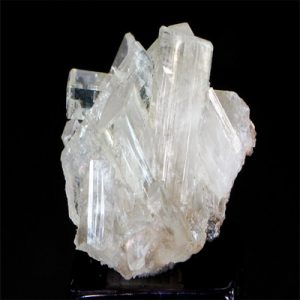Thaumasite
Thaumasite is an extremely rare gem and a member of the Ettringite Group of minerals that includes Charlesite, Ettringite, Sturmanite, and Thaumasite. It was discovered at the Bjelke Mine, Åreskutan, Åre, Jämtland, Sweden in 1878. It is a silicate mineral with chemical formula Ca3Si(OH)6(CO3)(SO4)·12H2O. Its Mohs hardness is 3.5 and it has a specific gravity of 1.88 to 1.90 and it’s optically uniaxial negative with indices of refraction of nω = 1.507 and nε = 1.468. It is a soft mineral but seems to harden with exposure to air. Thaumasite occurs as colorless to white prismatic hexagonal crystals, typically as acicular radiating groups. It also occurs as fibrous masses Sources of gem quality crystals include Paterson, New Jersey and the Kalahari manganese fields of the Northern Cape Province, South Africa.
| Category: | Sulfate minerals |
| Crystallography: | Hexagonal – Dipyramidal |
| Crystal Habit: | Crystals prismatic, to 5 cm; typically acicular, radiating; powdery, compact, massive. |
| Twinning: | None |
| Cleavage: | Poor, Indistinct |
| Fracture: | Subconchoidal |
| Tenacity: | Brittle |
| Moh’s Hardness: | 3.5 |
| Density: | 1.88 – 1.90 (g/cm3) |
| Radioactivity: | Not Radioactive |
| Color: | Colorless, white, pale yellow. |
| Transparency: | Transparent to Translucent |
| Luster: | Vitreous, Silky, Greasy |
| Refractive Index: | 1.458 – 1.507 Uniaxial ( – ) |
| Birefringence: | 0.0390 |
| Dispersion: | Very Weak to None |
| Pleochroism: | None |


